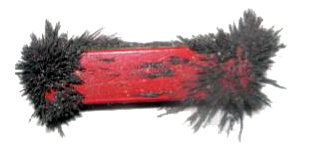Boojho dipped a bar magnet in a heap of iron filings and pulled it out. He found that iron filings got stuck to the magnet as shown in Fig. 13.4.
(i) Which regions of the magnet have more iron filings sticking to it?
(ii)What are these regions called?

The poles of the magnet will have more number of iron fillings attached to it. It is because the magnetic strength is maximum at the ends of the magnet.
Topper's Solved these Questions
- FUN WITH MAGNETSBook:NCERT EXEMPLARChapter:FUN WITH MAGNETSExercise:SHORT ANSWER QUESTIONS
Explore 4 Videos
- FUN WITH MAGNETSBook:NCERT EXEMPLARChapter:FUN WITH MAGNETSExercise:LONG ANSWER QUESTIONS
Explore 7 Videos
- FUN WITH MAGNETSBook:NCERT EXEMPLARChapter:FUN WITH MAGNETSExercise:LONG ANSWER QUESTIONS
Explore 7 Videos
- ELECTRICITY AND CIRCUITSBook:NCERT EXEMPLARChapter:ELECTRICITY AND CIRCUITSExercise:LONG ANSWER QUESTIONS
Explore 4 Videos
- LIGHTBook:NCERT EXEMPLARChapter:LIGHTExercise:LONG ANSWER QUESTIONS
Explore 3 Videos
Similar Questions
A bar magnet is immersed in a heap of iron filings and pulled out. The amount of iron filling clinging to the
View SolutionA piece AB of the magnetitie is dipped in a leap of small iron filings. It is observed that a cluster of iron filings stick to the ends A and B while there is practically no iron filing stick to its central region.
The central region or called
View Solution
Knowledge Check
A bar magnet is dipped in iron filings and taken out. Which of the following observations is correct?
AThe maximum quantity of filings gets sticked to the ends of the magnet.BThe maximum quantity of filings gets sticked to the middle.CThe filings gets uninformly distributed.DThe maximum quantity will be sticked at the north pole only.Dipping a bar magnet into a box of iron filings results in a larger number of iron filings stick to the poles or ends than at the center portion because ________.
AOnly ends are dipped in the boxBThey are ends of a magnetCThey are easier to attach at the edges than at the centreDThe strength of the magnet is more at the polesDipping a bar magnet into a box of iron filings results in a larger number of iron filings stick to the poles or ends than at the center portion because ________.
AOnly ends are dipped in the boxBThey are ends of a magnetCThey are easier to attach at the edges than at the centre.DThe strength of the magnet is more at the poles
A bar magnet is dipped in a leap of small iron filings. It is observed that a cluster of iron filings stick to the ends A and B while there is practically no iron filing stick to its central region.
Answer the following questions
End A is called
View SolutionThe attractice of iron filings in a magnet is maximum at
View SolutionA magnet is rolled in a mixture of iron filings and sulphur powder. It is observed that
View SolutionA magnet is rolled in a mixture of iron filings and sulphur powder. It is observed that
View SolutionA magnet is rolled in a mixture of iron filings and sulphur powder. It is observed that
View Solution

